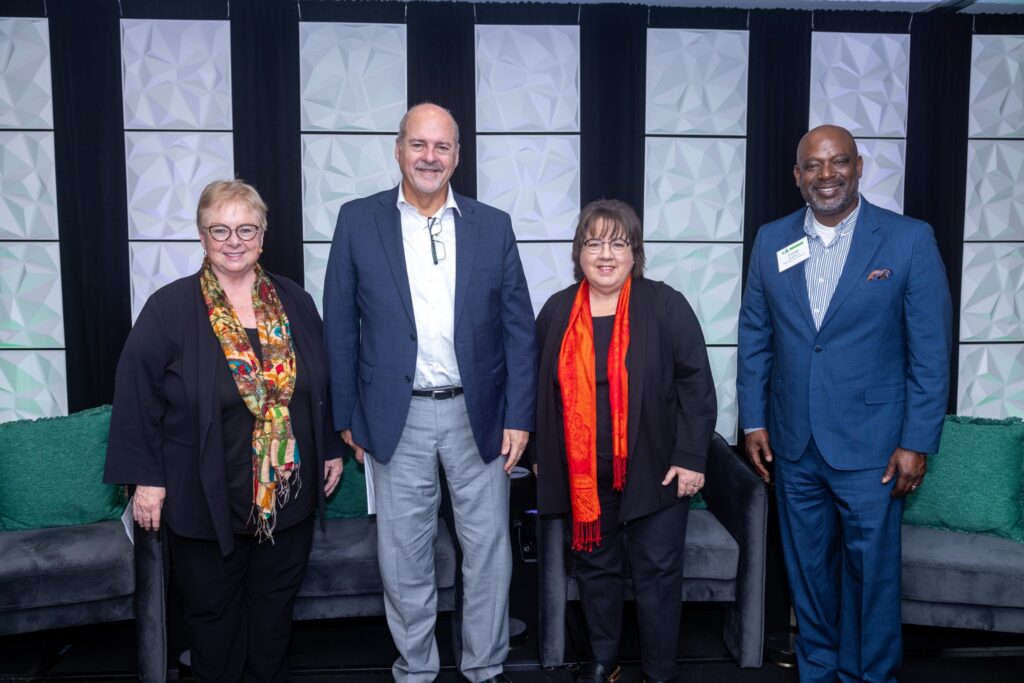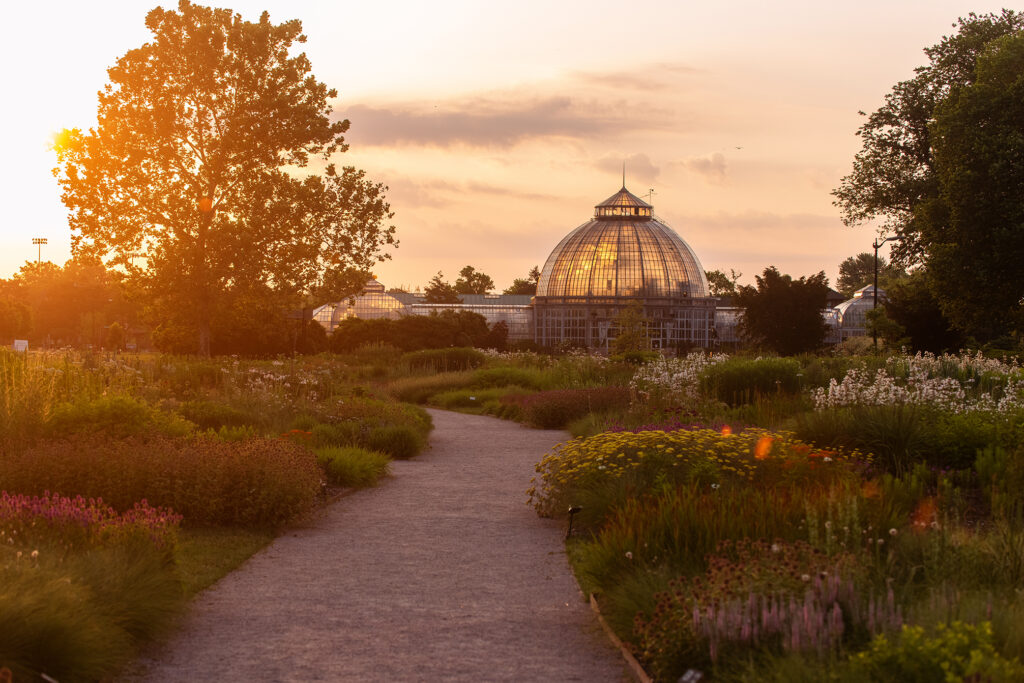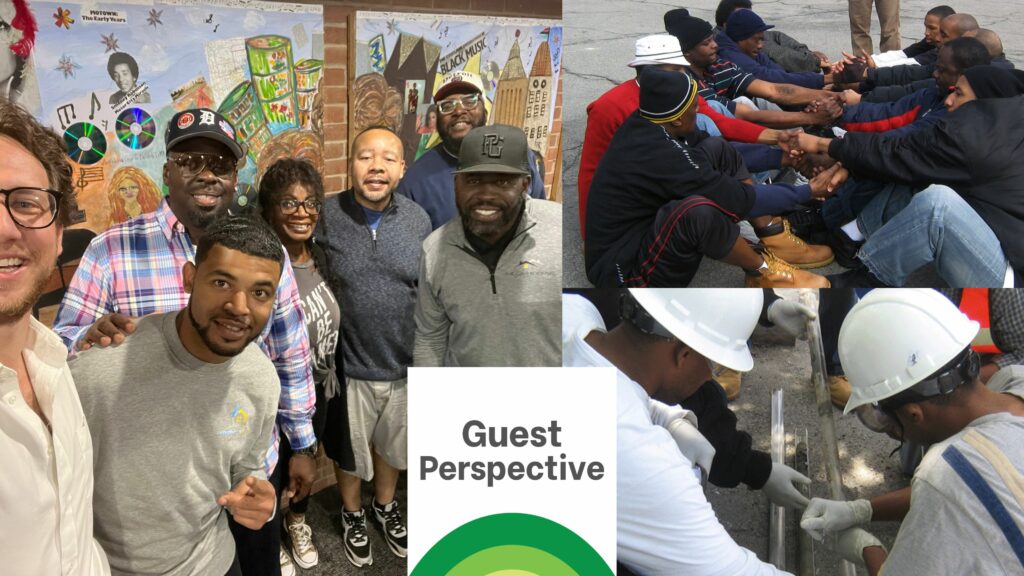Restoring Detroit’s Tree Canopy

Detroit was once known as the “city of trees,” but disease, invasive insects, and budget cuts over time have decimated our area’s distinctive tree canopy. But efforts are underway to replenish trees while also providing job training, green spaces, education, and community engagement. On Oct. 31, 2024, Sustainable Business Network Detroit hosted an informative discussion sponsored by the Fred and Barbara Erb Family Foundation regarding these efforts and how restoring tree canopy benefits individuals, neighborhoods, businesses, and the economy. The panelists were: Lionel Bradford, president and executive director, Greening of Detroit, a nonprofit focused on enhancing the quality of life for Detroiters by planting trees, providing job training, and involving youth in the education of the natural environment. It involves Detroiters in the process through community engagement, green spaces, education, and jobs. Maureen Donohue Krauss, president and CEO, Detroit Regional Partnership. DRP works to serve as a single point of contact for information, connection to services, incentives, and data for businesses who want to locate or expand in the 11-county Southeast Michigan Region. Robert Riney, president and CEO, Henry Ford Health, and leader of HFH’s $4 billion Destination: Grand initiative. The project includes a $2.2 billion expansion of HFH’s Detroit campus anchored by a new state-of-the-art hospital facility that will span 1.2 million square feet. It includes a 20-story patient tower, with three floors dedicated to providing intensive inpatient physical medicine and rehabilitation in partnership with the Shirley Ryan AbilityLab and its own Central Energy Hub, making it one of the largest fully electric-capable hospitals in the country. The event was moderated by Terry Barclay, president and CEO of Inforum, and chair of SBN Detroit. Some of the takeaways: The case for tree canopy Lionel: Growing up in Southeast Louisiana – which is very hot – you quickly learn the value of a tree. It’s also a sportsman’s paradise – We did a lot of hunting, fishing, and camping, and I developed a great appreciation for the environment and its value. I also love people. The work that we do is about people at the end of the day, so when we do this work it’s to build community and neighborhoods. We try our very best – changing landscapes and lives is our motto. When someone has been incarcerated for 20 years and needs a second chance, they can come through your program – the Detroit Conservation Corps – and they can be trained and support their families. You can train people to put trees in the ground and maintain them. Maureen: Part of my role is to inform people that economic development is more than just a new factory in your town, more than just a tax abatement. It’s creating an environment that both people and companies want to be in. Sixty percent of our projects are from international companies – when people come here for the first time, they have expectations of what a first-class city looks like… Think about Paris and its phenomenal tree canopies. People want that here. I did a little research before this event: Homes with trees sell two days faster and for 15% more than homes without. Tree value increases with age – the cost of trees has 100% payback. Three properly placed trees can reduce air conditioning by 56% and reduce home heating bills by 10% by serving as a windbreak. Bob: You may think what does a healthcare system have to do with tree canopies? HFH is absolutely committed to increasing the health of communities – the role that hospitals and doctors play is about 20%. We don’t underestimate the power of that 20%, but true health – meaning how long people will live and have a high-value life – is a partnership of healthcare, policy, and environmental factors – which are huge. You may have seen that the biggest determinant of your health is the ZIP Code that you live in. You need to have fabulous healthcare, access to it, economic security, environmental security, and food and nutrition security. At HFH we need to be a population health company – we pick and choose how we should make our mark and one of the things we believe in is the power of the tree. We have to walk the talk. The economic benefits of tree canopy Maureen: Our organization has three pillars: market, grow, and support. It’s so much better now. People are curious to hear about Detroit and see what’s happening. Talent is No. 1 – we have the second-highest amount of engineers in the country and have experienced manufacturing talent. As one of my teammates says, it’s workforce, weather, and water. When you talk about climate change, Michigan will be in the top five least affected. The right amount of tree canopy and how trees are sourced Lionel: American Forests did a study and determined that a city the size of Detroit should be at 40%. Right now we’re at 26%. We lose about 2,000 trees a year, so those have to be taken into account. We get most of our trees from New York and Indiana and, more recently, Wholesale Tree Inc. in Northern Michigan. More importantly, we’re growing our own trees now – running the Walter Meyers Nursery in Rouge Park, which is owned by the city. We’re very intentional about turning into a full-fledged operational business. Last year, we harvested our first set of trees. We have lost a lot of trees over time, and the reason we have lost a lot of those is because the city lacked the resources, and dead trees were not removed and were taken down by storms. This administration has done a great job by taking trees down when dead and dying. Working with DTE has been quite thrilling – they have given financial support to planting trees but also to making sure that the next generation of environmental stewards are trained by supporting our Green Corps summer programs and also the tree
New Leadership to Focus on Sustainability, Connectivity, Infrastructure

Meagan Elliott began her tenure as president and CEO of the Belle Isle Conservancy on July 1, following a decade with the city of Detroit, culminating in serving as chief parks planner and deputy CFO overseeing development and grants. Elliott spearheaded the Joe Louis Greenway Framework Plan and played a pivotal role as the city lead in a $350 million campaign for a unified greenway encompassing the Joe Louis Greenway and the Detroit Riverfront. The Belle Isle Conservancy is dedicated to safeguarding the natural environment, preserving historic structures, and enhancing Belle Isle as a public park for the enjoyment of all, now and in the future. According to the Michigan Department of Natural Resources, 5.6 million people visited the park last year. SBN Detroit interviewed Elliott about the conservancy’s approach to sustainability and what impacts her work will have on Southeast Michigan businesses and residents. Q: What part will sustainability play in your new role? A: Sustainability is fundamental to everything we do, and I want to lift and advance it in new ways. The Belle Isle Conservancy has done and continues to do a lot of work toward this. One example is the Keep Belle Isle Beautiful campaign focused on reducing plastic waste on the island and in waterways. That initiative has taken off and now goes far beyond the cleanups themselves, focusing on environmental stewardship and informing educational programming that helps to drive our future leaders. Caring for our planet forms the foundation of all our endeavors and is a filter for how we approach all our work, whether it be in support of habitat restoration, capital projects on the island, or new types of programming moving forward. I’m eager to collaborate with the Michigan Department of Natural Resources in this effort. Q: How does your background position you for this role? A: It’s in a couple of important ways. My tenure as chief parks planner was particularly formative, involving comprehensive work across all city green spaces, from neighborhood parks to a 30-mile greenway. When we consider Detroit’s park infrastructure, connectivity emerges as a fundamental concept. Historically, Belle Isle has been perceived as a separate entity and not easily accessible. Moreover, with one in four people in Detroit lacking access to a vehicle, they face challenges moving around the city, being able to access our amazing metro parks system, or getting Up North. Belle Isle is a treasure that rivals all of these spaces, and here it is right in our front yard. Connecting to a system of green space via the riverfront and the Joe Louis Greenway is essential. Connectedness extends beyond physical spaces to encompass the desires of residents and businesses surrounding Belle Isle as well. The Belle Isle Conservancy plays a crucial role as a steward and advocate, driving initiatives that reflect community wants and needs. Also, my background in sociology has prepared me to spend time listening to residents and how they want to utilize their island and to make sense of the patterns that emerge in engagement with a diversity of constituents. Finally, I’ve spent the last three years as deputy CFO brokering partnerships between private funders, philanthropic entities, and public partners and making initiatives happen by creating coalitions of folks. I want to put that same energy and investment behind Belle Isle. Q: You led the Joe Louis Greenway Framework Plan, and were the city lead in the $350 million campaign for a unified greenway for the Joe Louis Greenway and the Detroit Riverfront Conservancy. How will this impact your work going forward? A: I have an example. On my first day as president and CEO of the Belle Isle Conservancy, I was speaking at a press conference during which $20.7 million was received from the federal government for the continuing construction of the Joe Louis Greenway. This was a grant that the team worked on while I was still working for the City of Detroit. But I was there as the co-chair of the Joe Louis Greenway Partnership and was able to highlight the connection from the Joe Louis Greenway to the Iron Belle Trail, which ultimately will connect Belle Isle to Ironwood at the tip of the Upper Peninsula through a network of greenways. Many individuals have dedicated themselves to this work for a long time, and I’m committed to utilizing my platform and voice to continue to advance this work. Belle Isle is the epicenter of both this amazing network of green spaces and the Great Lakes. I can’t imagine a better geography for foregrounding environmental stewardship than on this island. Q: What impact do you think the Belle Isle Conservancy has on businesses in Southeast Michigan? A: I see the economic impact of public space as vast. It directly relates to employee decisions on where they choose to live and work. Belle Isle ranks as the second most visited park in the country after Niagara Falls. I believe our efforts here are directly linked to attracting new talent to businesses in Southeast Michigan and bolstering our economy. Q: In what way will you work with area businesses? A: The conservancy already does a lot of work with businesses on many fronts. One of the most immediately valuable impacts businesses have on Belle Isle is our corporate stewardship days. Businesses bring their teams to help clean up the park and connect with each other. We also have a significant number of partners in the corporate community who see the value of Belle Isle for the community and invest in projects to help support the park. We also have the opportunity to look at the vendors utilized on the island and how to create more inroads for Detroit-based businesses to play a role in the construction, management, concessionaire, and other vendor partnerships. There are endless opportunities to work together. Q: What challenges do you expect to encounter from a sustainability aspect? A: The challenge is always prioritization and how to choose projects and
Detroiters Working for Environmental Justice’s Vision for Sustainability

LAPRISHA BERRY DANIELS IS EXECUTIVE DIRECTOR OF DETROITERS WORKING FOR ENVIRONMENTAL JUSTICE AND A LEADERSHIP COMMITTEE MEMBER FOR SUSTAINABLE BUSINESS NETWORK DETROIT DWEJ’s vision for sustainability is rooted in the three pillars of sustainability: health and happiness of community members, a healthy local environment free from hazards and harm, and economic vitality. As an organization that focuses on environmental justice and strives to have the voice of the community-centered as decisions are being made that impact their health (physical, mental, spiritual, and economic), we assert that community members can envision and create healthy communities that meet their immediate and distal needs. A healthy community is one in which all systems work together to support the health and well-being of all its members. Local businesses are part of the community’s ecosystem and thus play a unique role in supporting the health and well-being of the community. Ideally, the relationship between community members and local business is mutually beneficial as they prioritize health and co-create a healthy community. Local businesses and community members can work together to identify threats to community well-being and create strategies to address challenges. In Detroit, and beyond, climate change threatens our ability to achieve and maintain physical, mental, spiritual, and economic health. As we experience more extreme weather locally, such as extreme heat and annual “100-year floods”, we recognize that our built environment may not be able to weather the storm (pun intended). Unfortunately, our existing residential housing stock and current construction practices are too often ill-suited for current and future climate conditions. The mismatch between what is available and what is needed creates threats to the health of people and planet. DWEJ developed a contractor accelerator program that focuses on contractors increasing their awareness about ways to improve the built environment to mitigate risks related to climate change while centering sustainability. DWEJ’s contractor accelerator program, Building Health, serves as an incubator to support peer-to-peer learning among Detroit-based, Detroit-serving contractors of color. Building Health increases contractors’ awareness and implementation of “environmentally responsible and resource-efficient” practices that have: Bottom-line business benefits Individual and community health benefits Decrease environmental degradation. Building Health increases contractors’ understanding of the impact they can have on health. For example, participating contractors are presented with strategies for upgrading and greening residential housing in ways that include the use of various building methods and materials that can make homes more energy efficient. These improvements decrease greenhouse gas emissions, improve the health and comfort of the home, and improve the economic health of the occupants by reducing the cost of utility use. Participants receive financial and technical assistance to implement practices as part of the program as well. Additionally, contractors learn how to best communicate the benefits of sustainable repair and rehab practices to clients. The role of local contractors is just one example of the opportunity our community has to transform our ecosystem and economy for the better. There is a unique and distinct role that local business plays in supporting people and planet. Sustainability is an iterative process where we must work collectively toward the goal of having healthy and vibrant places in which to live, learn, work, play, and pray. — Check out Laprisha Berry Daniels’s recent #TEDTalks: Lessons from the Past on Adapting to Climate Change Be sure to subscribe to our newsletter for regular updates on sustainable business practices in and around Detroit.


